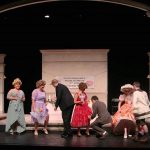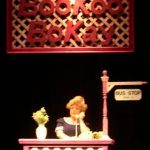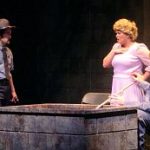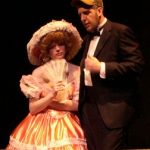Fall Production
The Taming of the Shrew
by William Shakespeare
directed by D. Keith Best
October 25-27, 2007
8:00 pm, Fine Arts Theatre
Hyman Fine Arts Center
Francis Marion University
DIRECTOR’S CONCEPT
If you have a seen a production of the The Taming of the Shrew in the past, the version you saw probably did not include the first two scenes of Shakespeare’s script. The story that is generally presented as The Taming of the Shrew is actually a “play-within-a-play-within-a-play”. In other words, there is the reality of the play, a false reality within that reality, and another false reality within that false reality.
The actual play is the story of the drunkard Christopher Sly. Sly is thrown out on the street where he passes out. A Lord happens upon him and decides to play a joke on Christopher Sly. This joke requires the Lord’s servants and attendants to “take on the roles” of Christopher Sly’s wife and servants and, when he wakes up, convince him that he is actually a Lord. This elaborate joke is the first play-within-a-play, though the character of Sly is not aware that he is a part of the play.
While the Lord is setting about this deception, a group of “players” arrive and offer to put on a play. The Lord hires them to put on the play for Christopher Sly, and this play, The Taming of the Shrew, becomes a play within the deception within the play. In most modern productions, this play presented by the players is usually presented as Shakespeare’s The Taming of the Shrew to the exclusion of all of the Christopher Sly material.
The usual reason behind the exclusion of the material is the lack of a closing scene with Christopher Sly in Shakespeare’s script. In reality, a closing scene existed during Shakespeare’s time, but is not part of the accepted or “good” script in existence today. However, there is another copy of Shakespeare’s play titled The Taming of A Shrew that is considered a “bad” copy—that is, the script was an attempt to copy Shakespeare’s original script or perhaps a script created by an actor that had been part of the original play at some point. This “bad” script is indeed not nearly as good as the accepted version. Though the plot remains basically the same, the character names change, some characters are added, and the language is not as poetic as Shakespeare’s.
I chose to use the Christopher Sly material. I think when the “shrew” story is presented as the play, the material seems too serious. When the story is presented as a play-within-a-play, the material is no longer taken so seriously. This extra layer also allows for a shift in style. To strengthen the Sly material, I included the Epilogue and a couple of very small bits from the “bad” version.
To separate the “shrew” play from the Sly storyline, I wanted to create two different worlds. I chose to do this in two ways.
The first is a blatant rip-off from the movie The Wizard of Oz. The Sly scenes will be played as traditional Elizabethan but in “black-and-white”. That is, costumes and sets will be in blacks, whites, and grays. Color appears when the players appear.
The second is what I call a “Bollywood” twist. Bollywood is a slang term given to a genre of the popular film industry in India. The name originates from a marriage of the words “Bombay” and “Hollywood”. The movies tend to be lengthy, melodramatic, anachronistic, and contain several musical numbers—usually big dance numbers with elaborate costumes and lots of choreography.
In this production, the basic idea is that the players who arrive at the Lord’s house have trained in India and are now traveling through Europe. Costumes will reflect that culture in addition to being very colorful. On a more selfish level, since Bollywood movies are willing to throw out most stylistic conventions for the sake of entertainment, the twist allows me to add dance numbers, anachronisms, and other silly things to the show.
— D. Keith Best
Spring Production
Dearly Beloved
by Jesse Jones, Nicholas Hope and Jamie Wooten
directed by A. Glen Gourley
April 10-12, 2008
7:30 pm, Fine Arts Theatre
Hyman Fine Arts Center
Francis Marion University
THE STORY:
The Futrelle Sisters, Frankie, Honey Raye and Twink, are throwing a wedding. Frankie has almost made herself sick with elaborate preparations for her daughter Tina Jo’s antebellum-inspired wedding, and the rumor mill in their small town of Fayro, Texas, is working overtime. No surprise there, the Futrelle Sisters have never been strangers to gossip. After all, they did survive the scandalous breakup of their almost-famous gospel singing trio, The Sermonettes.
But Twink’s desperate attempts to get her boyfriend of fifteen-and-one-half years down the aisle, Frankie’s ongoing conversations with their dead mother, and Honey Raye’s tendency to race to the altar at every opportunity have kept tongues wagging for years. In spite of her own marital problems, Frankie has held steadfastly to the hope that she can pull off one “final Futrelle occasion” with elegance and style with the help of the cantankerous wedding coordinator, Miss Geneva, who runs the local floral shop/bus depot. But on the day of the nuptials, Frankie’s hope begins to dim when she discovers Twink’s alternative solution to an expensive catered wedding dinner is a potluck supper sponsored by Clovis Sanford’s House of Meat.
When the prodigal Honey Raye arrives at the church in skintight gold lamé, consumed by hot flashes and a steely determination to right old family wrongs, Frankie’s hope is shaken. It is lost completely when word reaches the church that Tina Jo and her fiancé have fled Fayro and eloped. The sisters ultimately pull together to find ways to keep the unsuspecting guests in the pews while a highway patrolman races off to track down the runaway bride and groom. As a last resort, and to the delight of the citizenry of Fayro, Texas, The Sermonettes reunite and sing again.
— Dramatists Play Service











